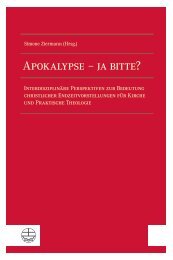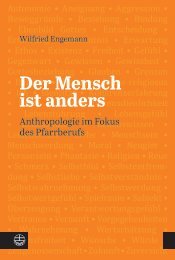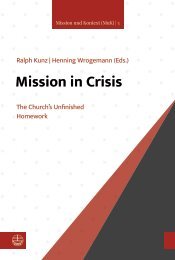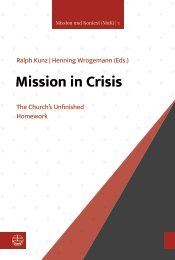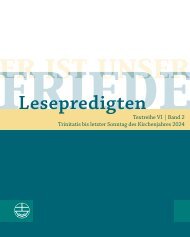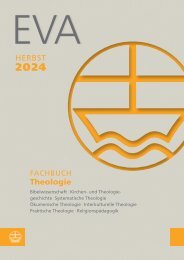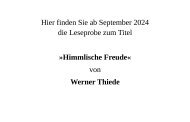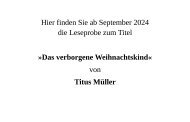Phillip A. Davis, Jr. | Daniel Lanzinger | Matthew Ryan Robinson (Eds.): What Does Theology Do, Actually? (Leseprobe)
You also want an ePaper? Increase the reach of your titles
YUMPU automatically turns print PDFs into web optimized ePapers that Google loves.
Is it in the Bible? 91<br />
standing of the biblical text in its original context, and the boundaries that need<br />
to guide our appropriation of the text in our contemporary context.<br />
2. Brief History of Developments and Methods in<br />
Biblical Interpretation<br />
Prior to any attempt to renegotiate interpretive boundaries, it is helpful to briefly<br />
describe certain historical developments and methods that have dominated biblical<br />
interpretation. For this, the three literary categories of finding meaning behind<br />
the text, within the text, and before (in front of) the text are helpful. 3 This<br />
will provide us with not only a clue as to which interpretive boundaries are<br />
marked and / or crossed by each of the major interpretive categories, but also<br />
which concerns motivated the various interpretive categories.<br />
Meaning ‘‘behind the text’’ is what has come to be known in biblical studies<br />
as historical-critical study of biblical texts. Porter and Stovell identify three salient<br />
features of historical criticism that distinguish it from other approaches: first,<br />
its focus on the evolutionary models of biblical texts; second, its focus on historical<br />
reconstructions of biblical texts, and third, its focus on the original or intended<br />
meaning of the text. Simply stated, historical-critical exegesis seeks to locate<br />
the text, the author, and readers within their historical contexts.<br />
The ‘‘within the text’’ category of biblical exegesis emerged as a remedy to<br />
the weaknesses of the historical-critical approaches that sought for meaning<br />
behind the text. This is a structuralist approach to hermeneutics, seeing meaning<br />
as residing within the text in its linguistic structure, not behind it. This approach<br />
led to the emergence of literary criticism, prominent in the 1970s. 4<br />
Narrative<br />
criticism and other related approaches within the broader framework of literary<br />
criticism focus ‘‘on the text as the autonomous means of transmitting meaning,’’ 5<br />
largely independent of what is behind the text. By implication, this approach is a<br />
shift from evolutionary models, which concern themselves with the processes of<br />
development of the text, to communication models, which focus on the nature of<br />
the text in its final stage as we have it. The weakness of this approach, in the<br />
light of our interpretive boundaries, is its neglect of the historical location of<br />
meaning on the one hand, as well as the contemporary location of meaning on<br />
3<br />
For this brief history of the developments and methods in biblical interpretation, we will<br />
depend on the summary presented by Porter and Stovell, Biblical Hermeneutics, 12, 13---<br />
20.<br />
4<br />
Narrative criticism has its theoretical basis in what was known in secular literary criticism<br />
as New Criticism, a form of literary reading that dominated literary theory from at<br />
least the 1950s to the 1970s (cf. Porter and Stovell, Biblical Hermeneutics, 17).<br />
5<br />
Porter and Stovell, Biblical Hermeneutics, 17.





